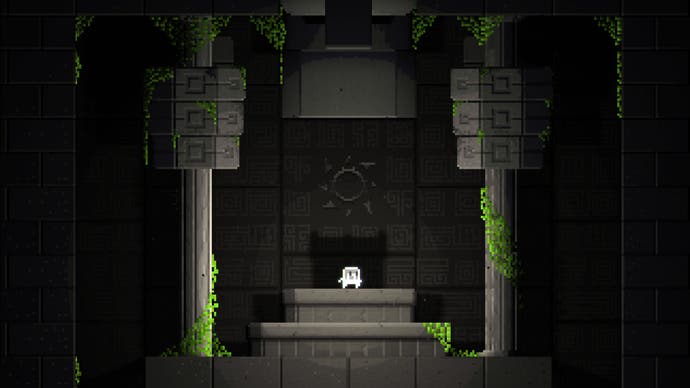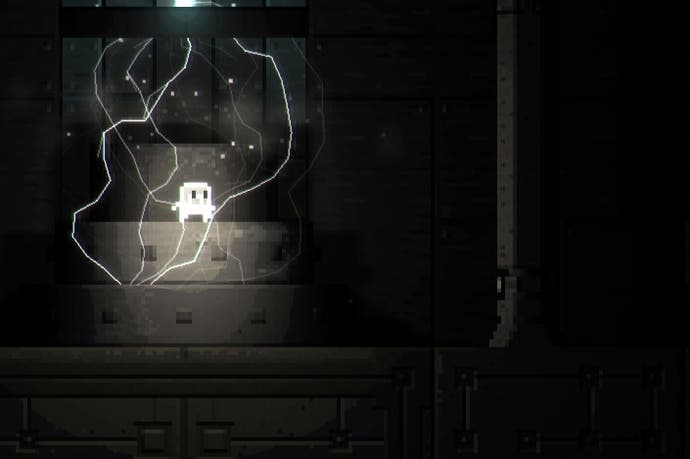The secrets of Chroma
Mark Foster's mysterious gem was a highlight of the Expo - here's why.
Mark Foster is a man who loves secrets. Not necessarily the messy, sinister kind - I only spoke to him on Skype for 30 minutes so I couldn't really tell you if that's the case, and he seems like an upstanding sort - but rather the kind that snag you in a video game, waiting to be unraveled; those little mysteries that give games like Dark Souls and Fez so much of their magic.
Chroma, which Foster has been working on for two years, is a game that's full of secrets. They're hinted at in etchings on the damp walls of the sewer you're plunged into, or in the strange murals that you set alive. They're there, too, beyond the pixel-art, within mechanics that are just as strange and wonderful as the world they churn behind.
Chroma's a game that's reluctant to explain itself, but more than happy for you to investigate. "It's one of those things where the deeper people go into it the more they discover," explains Foster, a chirpy former software engineer based in Manchester who gave up his day job 8 months ago to pursue his passion project full-time.

"It happens in Braid a bit as well, and it's what Jonathan Blow calls the joy of discovery. And that's what I love - I just love pumping loads of secrets into my game. I don't really care if people find them or not, which is the better way of doing things I think. If someone stumbles upon something and chases a rabbit down a hole and it takes them somewhere new, I think that's a really cool thing."
I first fell down that rabbit hole at the Expo late last month, and it's an experience that's been prickling in my memory since. Initial impressions have Chroma down as another cutesy, arty retro-styled platformer that's riding on the coat-tails of Super Meat Boy and Fez, but Foster's game is their equal rather than a pretender. That much is clear in one magical moment when the core mechanic becomes clear: running and jumping through a series of monochrome tunnels, there's an insurmountable ledge prefaced by a mural that politely, quietly flashes a blue 'X'.
Press that button on the controller, and your avatar - a cute, squat fellow who looks like an ethereal Domokun - switches from brilliant white to a black silhouette. You're in darkness, literally and figuratively, meandering around in the shadows and wondering what exactly is so special about this special ability. And so you wander some more, until....
The moment you unravel Chroma's first, most fundamental secret is one so special I'm inclined not to spoil it for other players - though if you've seen videos and screenshots you've likely worked it out for yourself. It's an inversion of expectations, and of the game world, that's as spectacular as the first time you realised you could spin the world on its axis in Fez. It's also something I implore you to discover yourself.
"This is why I don't post that much about it online in dev blogs," says Foster as he recalls delighting in the stream of players experiencing that moment for themselves at the Expo. "I'd rather people would just play it and find stuff on their own. I hate spoilers anyway - if I'm reading a book or watching a TV show and someone spoils it it's the worst thing."
After working through Chroma's brief demo - a section pulled wholesale from the opening of the game, where the pace is somewhat slower than the remainder - I wondered whether Foster could retain that level of invention, and whether he could replicate that initial, magical moment. He's certainly aiming to - Chroma's levels open up as you unlock more powers, the end result a twisting and artful take on the Metroidvania template.

"I wanted to do this basic idea that I had in my head for ages: the basic premise was this Metroidvania adventure, which I started doing in my spare time," says Foster. "For me wanting to make the game was about making a world. I've always wanted to make my own world and place, ever since I was a kid playing Sonic the Hedgehog, I always thought I'd really love to make my own little world like Green Hill Zone. The original idea was that you'd collect colours, and the colours would give you different powers: red would give you extra power so you could punch through boulders and stuff like that."
Chroma's evolved, though, from a multicoloured world to a monochrome one - albeit one that's splashed with occasional light touches of colour. The rest remains, though, and there's still the promise of a world of secrets beyond that seen in the initial, brief demo, and where there's hope for mechanics as inventive as the one that props up those opening few minutes.
And now that the first secret is out, it seems that other people are getting in on it too. After a series of excited reports from its appearance at the Expo's indie arcade, Foster attracted some interested parties - Shahid Ahmad, one of the most prominent men behind Sony's indie push, was pointed towards the demo at the show, and there's obviously interest in versions both on the Vita, where it would be a natural fit, and the PlayStation 4. Here's hoping it makes it across to those platforms - Chroma's a game of rare charm and wit, and its secrets deserve to be discovered by as many people as possible.

